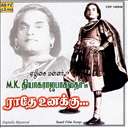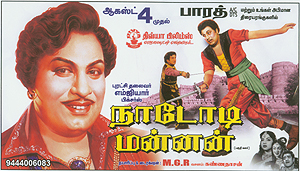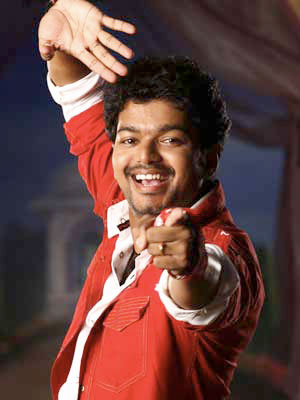|
http://www.srilankaguardian.org
Wednesday, June 2, 2010
The star trek from Chintamani to Vijay : Links
between South Indian films and Sri Lanka!
by Lucien Rajakarunanayake
  
(June 02, Colombo, Sri Lanka Guardian) It was in the late 1940s that
I saw it or else I would not remember it. The bioscope, as films
were known at the time, was screened at the Plaza Theatre at
Wellawatte. I recall waiting in the long queue with my aunts to whom
an evening watching the bioscope was a very special occasion. Their
interest was keener because film was "Chintamani" – the South Indian
block buster of that time, long before the term became common
parlance in cinema lingo.
I still recall fragments of the film, which starred M.K. Thyagarajah
Bhagavathar, whose songs in the film had become hits over here too,
in what was then Ceylon. Chintamani ran for nearly six months or
more in Colombo, and it was house full all the while. Businessmen
were cashing in on this runaway popularity with the Chintamani name
being used for match boxes, candles and joss-sticks. Many children
were given the name too, by parents who must have seen the film
several times and were singing and humming the songs of Bhagavathar.
Chintamani’s huge success was soon followed by "Ambikapathy" again
starring Thyagaraja Bhagavathar, which broke all records of
Chintamani, both in South India and Ceylon.
Another memorable South Indian film was "Chandralekha" shown here in
the early 1950s that may well have broken the record run of
Chintamani. Made on a lavish budget of USD 600,000 (USD 28m plus at
today’s rates) it featured an ensemble cast comprising M.K.Radha,
Ranjan, T. R. Rajakumari, N. S. Krishnan and Maduram. It remains the
most expensive film ever made in the history of Tamil Cinema for
decades, and one of the highest grossing films in Indian cinema, and
gave its director SS Vasan a quick road to Bombay.
It was a time when the Sri Lankan cinema was struggling to be born.
The South Indian film was setting the trend in entertainment and it
was no surprise when BAW Jayamanne who had made his name in Sinhala
theatrical presentations decided to go to South India, with his
Minerva Players to produce what unexpectedly became the first
Sinhala talkie.
If local audiences that were not fans of western cinema of the time
were completely taken up by South Indian films, to the emerging film
makers of Sri Lanka South India was the lodestone of attraction for
their work. This is what brought about what can be best described as
an umbilical link between South India and the Sinhala cinema.
The first Sinhala movie released in Sri Lanka was "Kadavunu
Poronduva" (Broken Promise) produced by South Indian SM Nayagam, and
made in Madras (now Chennai), released in January 1947.
But even before that, in 1945, Nayagam had founded a company named
Chitrakala Movietone with a studio in Madurai for the express
purpose of making a Sinhala film for the Sri Lankan market. Nayagam
picked from several competitive scripts, to make a film around the
legendary love story between Prince Saliya, son of King Dutugemunu
and Asokamala, said to be a girl of the lower Chandala caste. It was
the stuff of great romance with the prince losing his succession to
the throne because of his love. The successful screen play was by
young Sri Lankan artiste Shanti Kumar.
However, disagreements between Nayagam and Shanti Kumar did not see
the project go through as planned. Instead Nayagam made a deal with
BAW Jayamanne and his Minerva Players to produce Kadavunu Poronduva
(Broken Promise).So it was that BAW Jayamanne’s venture into cinema
became the first Sinhala talkie to be screened in Sri Lanka, opening
at the Mylan Theatre, Colombo on January 21, 1947, barely one year
before the island gained independence.
Broken Promise or not in business, Shanthi Kumar did not give up
after Nayagam went with Jayamanne. He got Ceylon Theatres Ltd, the
major cinema owners in the country, interested in his venture and
"Asokamala" was filmed in Coimbatore, and screened in Colombo just
three months later in April 1947, at the Elphinstone, Colombo.
SM Nayagam who saw the opportunities for Sinhala cinema, decided to
move to Sri Lanka. He purchased land outside of Kandana, not too far
from Colombo, and built the Sri Murugan Navakala studios (later
known as the S. P. M. studios) which would for a time be the most
developed studio in the country. His move was also timely in view of
the restrictions that were to come later on travel to and from
India, and it was a major cost cutter, too.
In the nine years since the first Sinhala film was released in
Colombo, all Sinhala films were made in South India, and BAW
Jayamanne was the key name in the industry. Nayagam, continued the
South Indian influence with his films made locally, but heavy
influenced by the South Indian formula. There was little original
work, or contribution to developing a truly Sri Lankan cinema.
A major new entrant to the Sinhala cinema was K. Gunaratnam, who
produced "Sujatha" a runaway hit in 1953, launching a series of
successful productions. Previously he had dubbed several Indian
films into Sinhala.
From the time of "Broken Promise" in 1947, the voice of Rukmani Devi
was dominant in Sinhala films. Others could hardly match her
singing, and BAW Jayamanne had a guarantee of success with her
voice, singing songs set to popular songs of Hindi and South Indian
films. Gunaratnam challenged the dominance of Rukmani Devi, with the
innovative use of popular background singers of the South Indian
cinema, who lent their voices to his local stars. The audiences that
saw Sujatha heard Sinhala songs sung by Jamuna Rani, and Jikki. K.
Rani also lent her voice to Sinhala stars. As the trend caught on,
Lata Mangeshkar too signed for a Sinhala film. The Indian influence
was overwhelming.
Rukmani Devi often acclaimed as "The Nightingale of Sri Lanka", came
to the silver screen via the stage, in the many plays presented by
BAW Jayamanne through his Minerva Dramatic Club of Negombo. Having a
passion for singing, combined with a melodious voice, she was Sri
Lanka’s foremost female singer in the gramophone era, and later in
Sinhala films. Her singing in films was heavily influenced by the
styles of the Indian cinema both South Indian and Hindi.
Interestingly she was born as Daisy Rasammah Daniels to a Colombo
Chetty Christian family at Ramboda in Nuwara Eliya, where her father
John Daniel worked on a plantation and her mother, Helen Rose was a
teacher. Her acting and singing were equally popular among the Tamil
plantation workers of South India origin in the hill country, as
well as with the all other Sri Lankans – whether Sinhala, Tamil,
Moor, Malay or Burgher.
Another important influence of South Indian films on Sinhala
productions was the well known couple N. S. Krishnan and T.A.
Mathuram, known as the greatest comedy pair of Indian Cinema, who
came to prominence with "Ambikapathy". The Krishnan - Mathuram
combination in film humour led to the Sri Lankan comedy duo – Eddie
Jayamanne and Gemini Kantha, who were star attractions in all of the
early Sinhala films by Jayamanne’s Minerva Players. Unlike Krishnan
and Mathuram they were not husband and wife, with Eddie, a great
humourist and the brother of BAW, being married to singer Rukmani
Devi.
It was the production of "Rekawa" in 1956 by pioneer director Lester
James Peries that saw the first Sinhala film to be shot completely
out of studio and contain a truly Sinhalese storyline. That was the
beginning of the end of the tremendous influence that South India
had over the Sinhala cinema.
But even after, there were many productions that were based on South
Indian films or were carbon copies of them, with the most striking
example being "Allapu Gedera" (Next Door) considered by many as a
frame to frame copy of the South Indian Tamil hit "Adutha Veettu
Penn" (The Girl Next Door), the Tamil remake of a successful Bengali
comedy, which was a hit starring Anjali Devi, T. R. Ramachandran and
many other popular stars of the time.
The celluloid links between Sri Lanka and South India are not
confined to the influence of South India on the early Sinhala
cinema. Sri Lanka has given South India, one of its foremost stars
in M. G. Ramachandran (MGR) who was born at Nawalapitiya in the
central Kandy District. He left this country at a very early age,
before he took to acting at the tender age of seven years, being
brought up by his mother who had returned to India.
MGR’s entry to cinema was through the Boys’ Company Movement which
was very active in theatre in South India, where children below 10
dominated the theatre scene in Tamil. Indeed most of the male film
stars of South Indian Tamil Cinema of the period 1940s-1950s came
from this background. Among them were MGR, Sivaji Ganeshan, T. K.
Shanmugham, T. R. Mahalingam, T. R. Ramachandran, M. K. Radha, M. K.
Thyagaraja Bhagavathar, P.S. Govindan, and others who were child
stars of theatre before achieving the wider popularity of the
movies.
Making his film debut in 1935, in the film Sati Leelavati, directed
by Ellis Dungan, an American born film director who was a large
presence in the South Indian cinema, , MGR dominated Tamil cinema
during the Fifties and Sixties with multiple blockbusters. Starring
mainly in romance or action films, his big breakthrough came in the
1947 film Rajakumaari, written by M. Karunanidhi and rose to
super-stardom in 1954 after Malai Kallan, a film considered the
model for many of his other films that portrayed him as the saviour
of the poor and the oppressed.
MGR had a string of all-time blockbusters to his credit that
included Nadodi Mannan, Enga Veetu Pillai and Adimai Pen. He won the
National Film Award for Best Actor for the film Rickshakaran. Nadodi
Mannan, produced and directed by himself was an all-time success
re-released His contribution to Indian cinema earned him the Bharata
Ratna. All of his films were huge successes among Sri Lankan
audiences, with producers here looking to his style as the formula
for success in Sinhala films, having new emphasis on the struggles
of the poor.
Closely involved in politics MGR was a member of the Congress Party
till 1953, when he joined the Dravida Munnetra Kazhagam (DMK) with
the help of M. Karunanidhi. He was soon a vocal Tamil and Dravidian
nationalist and prominent member of the DMK, adding glamour to the
Dravidian movement then sweeping Tamil Nadu. After the death of his
mentor, Annadurai, MGR became the treasurer of DMK in 1969 after
Karunanidhi became the chief minister.
If MGR was popular among Sri Lankan audiences for his roles that
reflected the radicalism that was taking place in South Indian
society at the time, there was another South Indian actor NT Rama
Rao of the Telugu cinema who vied for popularity with him. The
specialty of NTR was films that depicted the Hindu deities, which
found an instant attraction to the Hindus here, as well as to the
Sinhala Buddhists, most of whom also had faith in several of the
Hindu deities. Both MGR and NTR had a great following among the
plantation workers of Sri Lanka, too.
If MGR’s radicalism and later association with the DMK as well as
his known championing of the poor was a major attraction for Sri
Lankan audiences, there was also the attraction of Sivaji Ganeshan
whose roles took social radicalism even further, and found a special
place among Sri Lankan viewers. While the Sinhala film was limited
in scope due to most producers moving with the older formula of
South Indian cinema, the Tamil films that came from South India
found very large audiences over here, with their strong themes of
social criticism and the demands for a place in the sun for the
poor.
Sivaji Ganeshan who was to dominate the Tamil cinema for many years
made his debut in Parasakthi in 1952, an instant hit in Tamil Nadu
and Sri Lanka. It co-starred actress Pandari Bai, and was scripted
and directed by the present Chief Minister of Tamil Nadu, M.
Karunanidhi. In a career spanning 6 decades, Sivaji Ganeshan has
donned innumerable characters. Right from Parasakthi, he has covered
almost all characters of society as well as puranic, historic and
the like, with fame coming from his versatility and expressive
prowess in cinema.
From puranic epic stories, such as his outstanding performance as
Bharatha in Sampoorna Ramayanam to Karnan, based on Mahabharatha,
where he played the memorable role of Karna, and historic roles as
Raja Raja Sozhan, Samrat Asokan, won him laurels from Tamil
audiences worldwide.. His performance as Lord Shiva in
Thiruvilayaadal remains a classic to date. In Navarathiri (1964),
Shivaji Ganesan donned nine different roles that represented the
nine emotional states of a person. His role in the film
Veerapaandiya Kattabomman won him the Best Actor Award at the
Afro-Asian Film Festival held in March 1960 at Cairo making him the
first Indian actor to get an award for Best Actor abroad. His roles
ranged from deities to puranic characters and freedom fighters,
right into mingling with the people as a leper, doctor, judge,
advocate, rickshaw puller and many more real life characters. Not
surprisingly, in 1959 he was the first Indian actor to be made a
Chevalier of the Ordre des Arts et des Lettres.
The influence of stars of the calibre of MGR and Shivaji Ganeshan
and their own association with Dravidian activists such as C. N.
Annadurai, the fist Chief Minister of Tamil Nadu and considered a
powerful voice of the Dravidian movement, and a forerunner in
introducing Dravidian ideology into movie scripts; as well as with
M. Karunanidhi, the present CM of Tamil Nadu, who scripted the
screenplay for Parasakthi, bringing it box office success with
radical comments against the social hierarchy of the caste system
and glorifying the Dravidian movement, made Tamil cinema play a
vital role in Dravidian politics.
Interestingly, five out of seven chief ministers from Dravidian
parties were actively involved in Tamil cinema either as writers or
as actors. MGR was the most successful, having launched his own
Dravidian party after personal differences with the leaders of DMK,
and rising to power as Chief Minister of Tamil Nadu mostly with the
help of his movie fans and low level cadres. Analysts believe the
legacy of politics in Tamil filmdom still continues, though less
prominently than in the 1950s to 1970s. It is also a subject
deserving of serious study by sociologists as to how much the
radicalism of the Dravidian movement expressed through its screen
heroes such as MGR, Shivaji and many others, and their script
writers and lyricists, contributed to the Tamil militancy that
emerged in Sri Lanka in later years, with the vast popularity that
South Indian cinema had here.
To give more of the links between South Indian Cinema and Sri Lanka,
one recalls that Malani Fonseka, acknowledged as the Queen of
Sinhala Cinema today, who has been named this year by CNN among
Asia’s greatest film actors of all time, and who is now a Member of
Parliament, in 1978 played a role opposite Sivaji Ganeshan in the
South Indian film "Pilot Premnath" that starred popular actress
Sridevi, too.
From M.K. Thyagarajah Bhagavathar to MK Radha, Ranjan, MGR and
Sivaji and Gemini Ganeshan as well as Aswathamma, T. R Rajakumari,
Padmini, Vyjayanthimala to Pandari Bai and Ranjini and the many
other heroes and heroines of the South Indian cinema have all been
idolized by Sri Lankan audiences. And today, fast capturing
popularity among audiences both in South India and Sri Lanka is
Vijay (Joseph Vijay Chandrasekhar), the Tamil actor and playback
singer. Just as the great stars of the past he too began as a child
actor. Vijay made his debut playing the lead role in Naalaya Theerpu
(1992). Since then he has gone places in films of action and
romance, winning the Tamil Nadu State Film Awards (1998) and
appointed Ambassador for the Chennai Super Kings in the IPL series.
Little is known of Vijay’s strong links with Sri Lanka, which come
with his marriage to Sangeetha Sornalingam of Sri Lankan Tamil
decent in August 1999, continuing Sri Lanka’s links with the South
Indian cinema/
From the days of the bioscope and films shown in tents to rural
communities, to the plush modern cinemas in Colombo and an ever
expanding audience, the South Indian cinema retains its links with
Sri Lanka, netting in good profits for distributors here and for the
producers in Tamil Nadu and elsewhere. It seems time for a special
celebration of this great tradition of cinematic friendship that has
grown through the past eight decades and more.
Courtesy:
http://www.srilankaguardian.org/2010/06/star-trek-from-chintamani-to-vijay.html |

